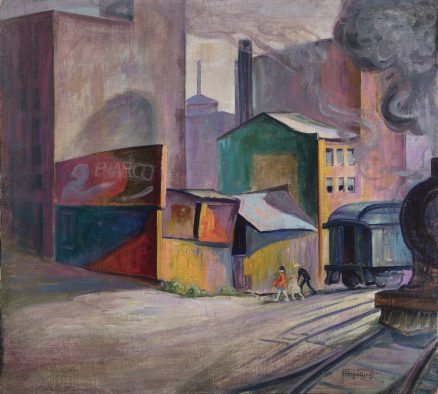Train Yard
, dated 1927Oil on canvas laid down on board, 27⅝ by 30¾ inches (sight)
- Categories
- Landscapes
- Zoom in on Artwork
- Print Page
- Email Page to Friend
Dwarfed by the inhospitable structures crowding the urban landscape, a man and woman with a white-clad child between them cross in front of a railway car in P. R. McIntosh’s Train Yard. Truncated at the far right, a steaming locomotive underscores the vulnerability of mere pedestrians in the inhumanly scaled landscape of modern industry. The buildings toward which the family moves offer no access, an opening to the left is cast in shadow, and the sky itself, glimpsed through wreaths of smoke, is almost eclipsed. A sign advertising ENARCO, a trademark for the grease and oil products made by the National Refining Company, reinforces the industrial character of the setting. Only the cheerful tints of the smaller structures near the center of the image relieve this otherwise dreary scene.
Just in his late twenties when he painted this work, McIntosh had recently moved from a teaching job at Ohio State University to Peoria, Illinois, where he had a joint appointment as director of the Peoria Art Institute and art instructor at Bradley Polytechnic Institute (now Bradley University). In September 1927, the Peoria Public Library held an exhibition of his paintings that featured recent Peoria city scenes, possibly including this work. A notice in a Bradley student newspaper described McIntosh as an artist “of the modern school” whose recent works “convey a feeling of pulsating vitality. He has purposefully omitted detail in order to more fully make use of [the] beauty of color.”i
This painting was also distinctly modern in its subject-matter. American artists had been picturing the contemporary urban and industrial scene since the turn of the twentieth century, typically in celebratory terms. Well before the Great Depression, however, more progressive artists introduced an element of critical commentary into their interpretations, often focusing on the city’s seedier side by highlighting decaying and purely utilitarian structures, as well as its working-class and immigrant social scene. Among the pioneers of such imagery were the New York-based artists known as the Ashcan School. Three members of the group were influential guest instructors at the Art Institute of Chicago when McIntosh was a student there, and his interest in urban imagery may reflect their example. Train Yard, with its notes of gay color oddly contrasting with the loneliness of the setting, blends gritty realism with fantasy, however. It suggests the alienating effects of the dehumanized industrial landscape, at the same time acknowledging its potential for accidental beauty and subtle mystery.
Wendy Greenhouse, Phd
Donated by M. Christine Schwartz to the Peoria Riverfront Museum, Peoria, Illinois, in 2022
i “Art Instructor Displays Work,” Bradley Tech, Sept. 22, 1927.
